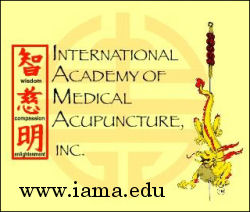Acupuncture & TCM Articles

Acupuncture Articles
by John A. Amaro L.Ac., Dipl.Ac.(NCCAOM), DC
 Dr. Amaro is an internationally known author, lecturer and practitioner beginning his practice of Acupuncture and Chiropractic in 1971. He has led 13 diplomatic Acupuncture study tours of The People's Republic of China escorting more than 500 doctors and practitioners. He has personally studied Acupuncture in nine separate Asian nations. Dr. Amaro is an internationally known author, lecturer and practitioner beginning his practice of Acupuncture and Chiropractic in 1971. He has led 13 diplomatic Acupuncture study tours of The People's Republic of China escorting more than 500 doctors and practitioners. He has personally studied Acupuncture in nine separate Asian nations.
He has received Certification in Acupuncture through the Columbia Institute of Chiropractic in 1973. This was one of the first Acupuncture postgraduate education programs for physicians in North America commencing in 1972.
He has been certified by the Waseda Acupuncture College in Tokyo, Japan in 1974 and graduated from the Chinese Medical Institute, Kowloon, China in 1976. He had previously taken postgraduate studies at the Tai Chung Medical School Taipei, China 1973.
THE DOCTORS NOTEBOOK
"CHINESE CUISINE-----GOOD OR BAD"
DR. DEBRA RICHEL & DR. JOHN A. AMARO
John A. Amaro L.Ac., Dipl.Ac.(NCCAOM), DC
We've always heard the Chinese as a nation, suffer from far less diabetes, heart disease and cancer, are much leaner than Americans in general and additionally, have astonishingly low cholesterol levels. One reason for this is the typical Chinese diet has the reputation of being high in fiber and low in fat with an emphasis on vegetables and grains and is known to be one of the healthiest diets in the world. This has been confirmed by the "Cornell-China-Oxford Project on Nutrition, Health and Environment", which to date, has been the largest nutrition study in history.
Why then all the recent media hype that Chinese food is just the opposite? Being loaded with fat, calories and sodium. It has been published, "Moo shu pork has twice the cholesterol of two Egg McMuffins" and "Lo Mein noodles contains as much salt as an entire Pizza Hut cheese pizza".
It just so happens that while the Cornell study findings were publishing the benefits of Chinese food, the Center for Science in the Public Interest (CSPI) in Washington, DC, had been doing it's own survey of 15 popular Chinese dishes prepared in moderately priced restaurants in Washington, San Francisco and Chicago. CSPI's results indicated atrocious amounts of sodium, calories and saturated fat in American restaurant prepared Chinese food.
So what's the story? Is Chinese food something we should avoid or is it a healthy alternative to the American diet? This is a significant question, since Chinese food is the USA's most popular ethnic cuisine. The answer, is that authentic Chinese food served in China is quite different than Chinese food prepared and served in America. In China, the rural diet contains 70% carbohydrates in the form of rice and vegetables and minimal fat. Only an ounce or two of chicken or pork is eaten at a time. The remainder of the diet comes in the form of tendons, ears and webbed feet which are comprised entirely of protein and collagen with zero fat and cholesterol. Chinese cooking (in China) utilizes scores of relatives in the calcium and iron-rich Brassica family such as bok choy, turnips, mustard greens and cabbage.
Unfortunately, Chinese restaurants in the United States mimic American traditions with beef and pork being the main event and vegetables secondary. Studies have shown, America's Chinese restaurants remain consistent with the standard American diet with 35% to 40% of calories coming from fat and 70% of protein from animal fat.
In addition, the styles of eating between both countries are entirely different. The Chinese philosophy and rules of life are based upon the duality of yin and yang, the opposing polarities in nature that creates balance. This sense of balance leads to healthier proportions e.g. 2 cups of rice to 1/3 cup of meat, one stir fried dish, one steamed, one pickled, and one poached per seating. If Americans would learn to eat in the authentic Chinese-style, where soybeans replace hamburgers and digestible vegetables became commonplace, there would be undeniable health benefits.
When the early Chinese immigrants first came to this country in the mid- 17th century and later in the 1800's as laborers to help build the Central Pacific Railroad in California and beyond, their customs and practices concerning food preparation was thought of as crude and strange to those observers of European descent who preceded them. The philosophy of eating, the importance of variety and the essential role of rice became with time, altered as the typical Chinese diet became diluted with the influence of America.
Today, there are a number of Chinese restaurants who understand genuine Chinese cooking techniques, Chinese cook books and classes are available, which makes the understanding of Traditional preparation available to all of us to bring into our own homes. A base of rice, noodles and grains, topped with vegetables, legumes and fruits. You always know when the meal is over in China - the oranges are served!
Traditional Chinese food prepared in the proper fashion is good for you but stay away from the abundance of fried foods which abound in Chinese/American cooking. Oh, and on your next visit to a Chinese restaurant, don't forget to read your Fortune Cookie.
|
